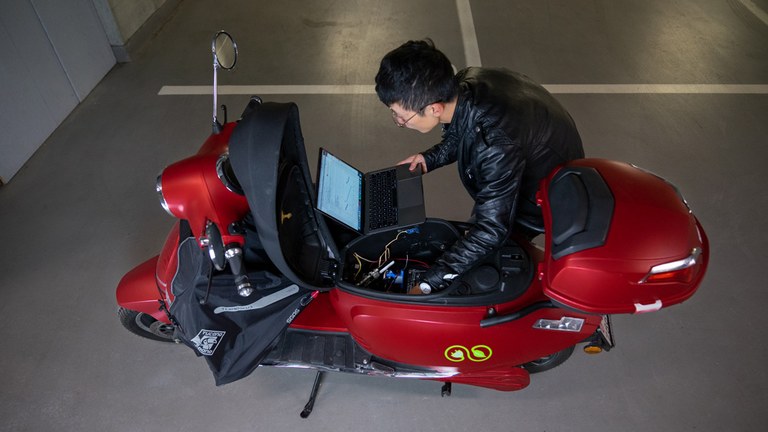A smart scooter to improve battery management
Electric vehicle fleets are not easy to manage. Batteries need time to be charged and their remaining autonomy depends on many variables, such as weather conditions, user habits and local circulation constraints. Having a model to smoothly anticipate battery maintenance can be a real advantage for a battery exchange network. Thanks to InnoSuisse, the Swiss federal innovation agency, the e-scooter rental company Mobi-Let is currently collaborating with Idiap’s researchers. By using e-scooters equipped with wireless sensors, they aim to develop and calibrate a battery management program. The project will last six months and includes a scooter based at the institute in Martigny.
“Can I reach my destination or how much autonomy do I have? These are some typical questions a user will have when using an electric vehicle,” explains Huajian Qiu, student in the Energy informatics research group. “The remaining electric charge isn’t enough to answer. The battery will last shorter or longer depending on the driving style, temperature and, of course, the road to reach a specific destination.” To monitor the battery and these parameters, the scientists used various sensors on the battery, such as a thermometer, a hygrometer, an accelerator, an ampere- and voltmeter, and a GPS. Thanks to the internet of things (IoT), they can access the data wirelessly. “When we combine our model with Google maps, we can estimate if a destination can be reached at a given time,” adds Qiu.

Moreover, such knowledge can improve the battery’s life thank to a better management of battery state of charge. This saves money and also diminishes the environmental impact by giving batteries a second life in stationary developments, such as grid independent battery exchange stations, where the older batteries can serve as buffer for the actively exchanged units.
Privacy and autonomy
To calibrate the machine learning model, scientists are using data – several battery cycles are usually necessary to learn from a given user pattern – and also data visualization tools. Sensors must be checked as well to ensure they are producing useful and accurate data. “During the development phase, we need to gather specific data to each user,” explains Jérôme Kämpf, head of the Energy informatics research group. “Of course, for privacy reasons, these data are not shared and only used within the institute.” In the next phase, during the commercial deployment, the company plans to use a specific tool to anonymize collected data thanks to a partnership with the HES-SO in Sion, using the PrYv solution. “The aim is to have a model which classifies individuals, while respecting their privacy. Machine learning is the best tool to reach this goal,” concludes Kämpf.
More information
- Energy informatics research group
- Mobi-Let
- Battery exchange network
